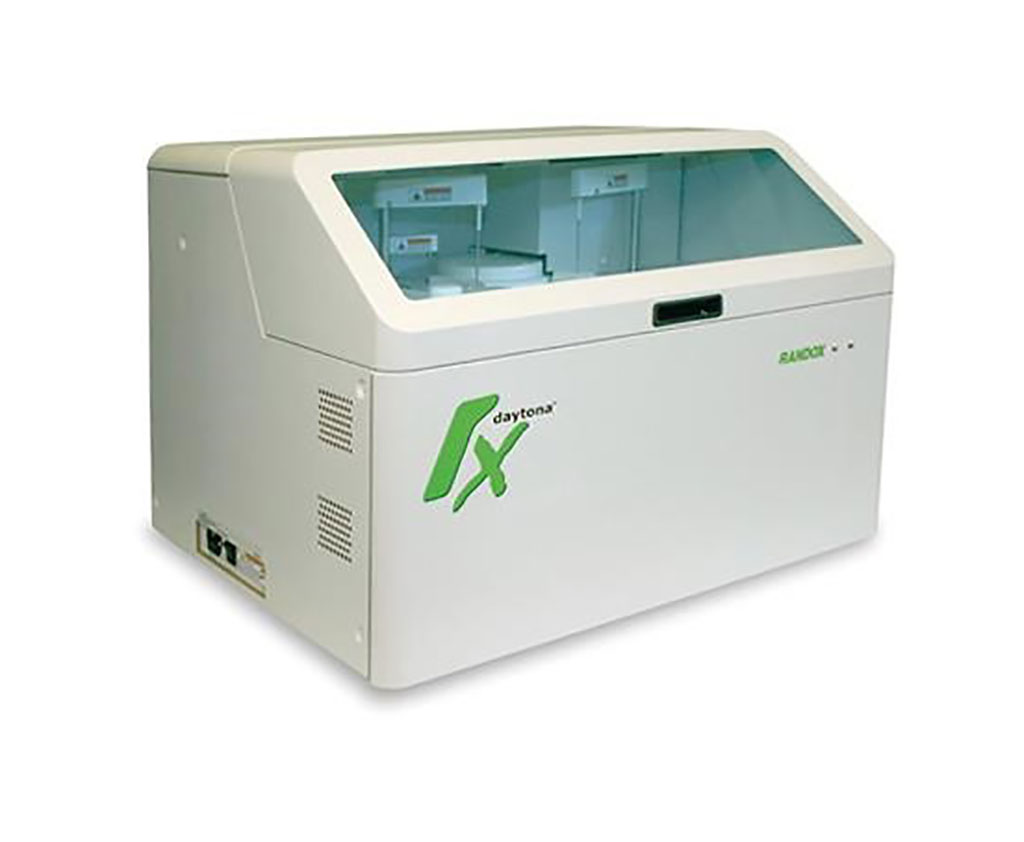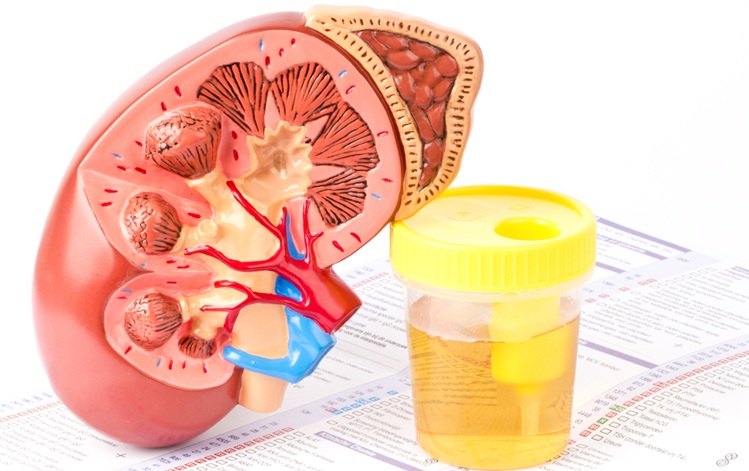Urinary Biomarkers Predict Acute Kidney Injury in Patients with COVID-19
|
By LabMedica International staff writers Posted on 08 Nov 2021 |

Image: The Randox RX Daytona clinical chemistry analyzer (Photo courtesy of BioAgilytix)
Acute kidney injury (AKI) is a sudden episode of kidney failure or kidney damage that happens within a few hours or a few days. AKI causes a build-up of waste products in the blood and makes it hard for the kidneys to keep the right balance of fluid in the body.
Biomarkers of kidney injury, inflammation, and repair may offer further insight beyond current standard methods of characterizing COVID-19-associated. Biomarkers can help to differentiate various types of kidney injury, and may be uniquely helpful in quantifying tubular injury in COVID-19.
Nephrologists at the Johns Hopkins University School of Medicine (Baltimore, MD, USA) and their colleagues collected urine samples after a patient’s admission with a confirmed COVID-19 test, with repeat urine sample collections attempted weekly thereafter for patients who remained hospitalized. The team analyzed data from 153 patients hospitalized with COVID-19 treated at two academic medical centers between April 2020 and June 2020.
The scientists selected nine candidate urinary biomarkers as primary exposure variables based on our prior work demonstrating associations of such biomarkers with adverse short and long-term kidney outcomes in other clinical settings. They additionally investigated the association of 10 inflammatory biomarkers with the primary outcome: urinary IL-1β, 2, 4, 6, 8, 10, 12, and 13; tumor necrosis factor alpha (TNF-α); and interferon-γ (IFN-γ).
Urine microscopy scoring was completed in a subset of 59 patients, using the IDEXX SediVue Dx platform (IDEXX Laboratories, Westbrook, ME, USA), with all 59 urine microscopy samples generating an automated report with 70 images each, which were reviewed manually. Urinary albumin and creatinine were measured using the Randox RX Daytona clinical chemistry analyzer (Randox, Crumlin, UK). All other biomarkers were measured using the Meso Scale Discovery (MSD, Rockville, MD, USA) platform.
The investigators reported a 2-fold higher levels of neutrophil gelatinase-associated lipocalin (NGAL), monocyte chemoattractant protein-1 (MCP-1), and kidney injury molecule-1 (KIM-1) were associated with increased risk of severe acute kidney injury or death in patients hospitalized with COVID-19. They also noted that subclinical AKI, defined by elevations in urinary biomarkers, was present in 30% to 50% of patients who did not manifest clinical AKI.
The authors concluded that they had identified significant associations between urinary NGAL, KIM-1, MCP-1, and EGF [epidermal growth factor] and the primary outcome of stage 3 AKI, requirement for dialysis, or death within 60 days of hospital admission. The discriminatory ability of the individual biomarkers EGF, NGAL, and MCP-1 alone was higher than that of urinary albumin alone and improved in pairwise combinations of these three biomarkers. Neither urine microscopy score nor the presence of viral RNA in the urine of patients with COVID-19 were associated with the primary outcome. The study was published on October 25, 2021 in the American Journal of Kidney Diseases.
Related Links:
Johns Hopkins University School of Medicine
IDEXX Laboratories
Randox
Meso Scale Discovery
Biomarkers of kidney injury, inflammation, and repair may offer further insight beyond current standard methods of characterizing COVID-19-associated. Biomarkers can help to differentiate various types of kidney injury, and may be uniquely helpful in quantifying tubular injury in COVID-19.
Nephrologists at the Johns Hopkins University School of Medicine (Baltimore, MD, USA) and their colleagues collected urine samples after a patient’s admission with a confirmed COVID-19 test, with repeat urine sample collections attempted weekly thereafter for patients who remained hospitalized. The team analyzed data from 153 patients hospitalized with COVID-19 treated at two academic medical centers between April 2020 and June 2020.
The scientists selected nine candidate urinary biomarkers as primary exposure variables based on our prior work demonstrating associations of such biomarkers with adverse short and long-term kidney outcomes in other clinical settings. They additionally investigated the association of 10 inflammatory biomarkers with the primary outcome: urinary IL-1β, 2, 4, 6, 8, 10, 12, and 13; tumor necrosis factor alpha (TNF-α); and interferon-γ (IFN-γ).
Urine microscopy scoring was completed in a subset of 59 patients, using the IDEXX SediVue Dx platform (IDEXX Laboratories, Westbrook, ME, USA), with all 59 urine microscopy samples generating an automated report with 70 images each, which were reviewed manually. Urinary albumin and creatinine were measured using the Randox RX Daytona clinical chemistry analyzer (Randox, Crumlin, UK). All other biomarkers were measured using the Meso Scale Discovery (MSD, Rockville, MD, USA) platform.
The investigators reported a 2-fold higher levels of neutrophil gelatinase-associated lipocalin (NGAL), monocyte chemoattractant protein-1 (MCP-1), and kidney injury molecule-1 (KIM-1) were associated with increased risk of severe acute kidney injury or death in patients hospitalized with COVID-19. They also noted that subclinical AKI, defined by elevations in urinary biomarkers, was present in 30% to 50% of patients who did not manifest clinical AKI.
The authors concluded that they had identified significant associations between urinary NGAL, KIM-1, MCP-1, and EGF [epidermal growth factor] and the primary outcome of stage 3 AKI, requirement for dialysis, or death within 60 days of hospital admission. The discriminatory ability of the individual biomarkers EGF, NGAL, and MCP-1 alone was higher than that of urinary albumin alone and improved in pairwise combinations of these three biomarkers. Neither urine microscopy score nor the presence of viral RNA in the urine of patients with COVID-19 were associated with the primary outcome. The study was published on October 25, 2021 in the American Journal of Kidney Diseases.
Related Links:
Johns Hopkins University School of Medicine
IDEXX Laboratories
Randox
Meso Scale Discovery
Latest Immunology News
- Blood-Based Liquid Biopsy Model Analyzes Immunotherapy Effectiveness
- Signature Genes Predict T-Cell Expansion in Cancer Immunotherapy
- Molecular Microscope Diagnostic System Assesses Lung Transplant Rejection
- Blood Test Tracks Treatment Resistance in High-Grade Serous Ovarian Cancer
- Luminescent Probe Measures Immune Cell Activity in Real Time
- Blood-Based Immune Cell Signatures Could Guide Treatment Decisions for Critically Ill Patients
- Novel Tool Predicts Most Effective Multiple Sclerosis Medication for Patients
- Companion Diagnostic Test for CRC Patients Identifies Eligible Treatment Population
- Novel Tool Uses Deep Learning for Precision Cancer Therapy
- Companion Diagnostic Test Identifies HER2-Ultralow Breast Cancer and Biliary Tract Cancer Patients
- Novel Multiplex Assay Supports Diagnosis of Autoimmune Vasculitis
- Blood Test Predicts Immunotherapy Efficacy in Triple-Negative Breast Cancer
- Simple Genetic Testing Could Predict Treatment Success in Multiple Sclerosis Patients
- Novel Gene Signature Predicts Immunotherapy Response in Advanced Kidney Cancers
- New Technology Deciphers Immune Cell Communication to Predict Immunotherapy Response
- AI Model Accurately Predicts MSI Tumor and Immune Checkpoint Inhibitor Responsiveness
Channels
Molecular Diagnostics
view channel
Urine Test Detects Early Stage Pancreatic Cancer
Pancreatic cancer remains among the hardest cancers to detect early. In the UK, around 10,000 people are diagnosed each year, but only 5% survive beyond five years. Late diagnosis is a major factor—more... Read more
Genomic Test Could Reduce Lymph Node Biopsy Surgery in Melanoma Patients
Accurately determining whether melanoma has spread to the lymph nodes is crucial for guiding treatment decisions, yet the standard procedure—sentinel lymph node biopsy—remains invasive, costly, and unnecessary... Read moreHematology
view channel
ADLM’s New Coagulation Testing Guidance to Improve Care for Patients on Blood Thinners
Direct oral anticoagulants (DOACs) are one of the most common types of blood thinners. Patients take them to prevent a host of complications that could arise from blood clotting, including stroke, deep... Read more
Viscoelastic Testing Could Improve Treatment of Maternal Hemorrhage
Postpartum hemorrhage, severe bleeding after childbirth, remains one of the leading causes of maternal mortality worldwide, yet many of these deaths are preventable. Standard care can be hindered by delays... Read more
Pioneering Model Measures Radiation Exposure in Blood for Precise Cancer Treatments
Scientists have long focused on protecting organs near tumors during radiotherapy, but blood — a vital, circulating tissue — has largely been excluded from dose calculations. Each blood cell passing through... Read moreImmunology
view channel
Blood-Based Liquid Biopsy Model Analyzes Immunotherapy Effectiveness
Immunotherapy has revolutionized cancer care by harnessing the immune system to fight tumors, yet predicting who will benefit remains a major challenge. Many patients undergo costly and taxing treatment... Read more
Signature Genes Predict T-Cell Expansion in Cancer Immunotherapy
Modern cancer immunotherapies rely on the ability of CD8⁺ T cells to rapidly multiply within tumors, generating the immune force needed to eliminate cancer cells. However, the biological triggers behind... Read moreMicrobiology
view channel
High-Throughput Enteric Panels Detect Multiple GI Bacterial Infections from Single Stool Swab Sample
Gastrointestinal (GI) infections are among the most common causes of illness worldwide, leading to over 1.7 million deaths annually and placing a heavy burden on healthcare systems. Conventional diagnostic... Read more
Fast Noninvasive Bedside Test Uses Sugar Fingerprint to Detect Fungal Infections
Candida bloodstream infections are a growing global health threat, causing an estimated 6 million cases and 3.8 million deaths annually. Hospitals are particularly vulnerable, as weakened patients after... Read morePathology
view channel
New Molecular Analysis Tool to Improve Disease Diagnosis
Accurately distinguishing between similar biomolecules such as proteins is vital for biomedical research and diagnostics, yet existing analytical tools often fail to detect subtle structural or compositional... Read more
Tears Offer Noninvasive Alternative for Diagnosing Neurodegenerative Diseases
Diagnosing and monitoring eye and neurodegenerative diseases often requires invasive procedures to access ocular fluids. Ocular fluids like aqueous humor and vitreous humor contain valuable molecular information... Read moreTechnology
view channel
Cell-Sorting Device Uses Electromagnetic Levitation to Precisely Direct Cell Movement
Sorting different cell types—such as cancerous versus healthy or live versus dead cells—is a critical task in biology and medicine. However, conventional methods often require labeling, chemical exposure,... Read more
Embedded GPU Platform Enables Rapid Blood Profiling for POC Diagnostics
Blood tests remain a cornerstone of medical diagnostics, but traditional imaging and analysis methods can be slow, costly, and reliant on dyes or contrast agents. Now, scientists have developed a real-time,... Read moreIndustry
view channel
Qiagen Acquires Single-Cell Omics Firm Parse Biosciences
QIAGEN (Venlo, Netherlands) has entered into a definitive agreement to fully acquire Parse Biosciences (Seattle, WA, USA), a provider of scalable, instrument-free solutions for single-cell research.... Read more
Puritan Medical Products Showcasing Innovation at AMP2025 in Boston
Puritan Medical Products (Guilford, ME, USA), the world’s most trusted manufacturer of swabs and specimen collection devices, is set to exhibit at AMP2025 in Boston, Massachusetts, from November 11–15.... Read more
Advanced Instruments Merged Under Nova Biomedical Name
Advanced Instruments (Norwood, MA, USA) and Nova Biomedical (Waltham, MA, USA) are now officially doing business under a single, unified brand. This transformation is expected to deliver greater value... Read more






















